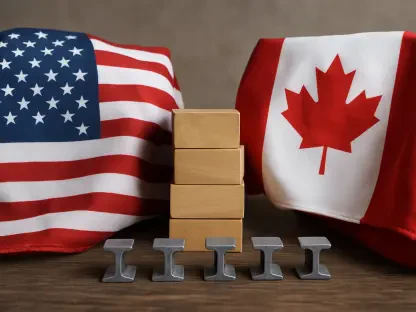As November unfolds, a palpable sense of caution has gripped global financial markets, with a pronounced “risk-off” mood driving investors away from speculative, high-risk assets toward safer havens, a shift fueled by a complex mix of persistent inflation, geopolitical unrest, and looming economic slowdowns. This change is sending ripples through commodity markets, reshaping valuations and strategies. Industrial metals like copper are under pressure, while gold emerges as a refuge, highlighting a stark divide in how different commodities weather this storm. This pervasive risk aversion isn’t merely a temporary reaction but appears to signal a broader recalibration of investor priorities, reflecting deep uncertainties about the global economic outlook. For market participants, grasping the nuances of this sentiment is vital, as it not only affects immediate portfolio decisions but also hints at long-term shifts in trade dynamics and financial stability. The following discussion delves into the root causes of this cautious mindset, explores its varied impacts on commodities, and considers the wider economic implications that could redefine markets for years to come.
Unpacking the Forces Behind Risk Aversion
A convergence of troubling global developments in November has created a perfect storm, fostering a risk-averse mindset among investors. Persistent inflation, particularly in core sectors like services, continues to defy expectations of a gentle slowdown, leaving markets uncertain about future monetary policies. The Federal Reserve’s internal disagreements over whether to cut interest rates or maintain a tighter stance only heighten this volatility, as investors grapple with the potential for higher borrowing costs or delayed economic relief. This uncertainty around central bank actions has become a central concern, pushing many to prioritize capital preservation over speculative gains in an environment where clarity is scarce.
Beyond monetary policy, geopolitical tensions are significantly contributing to the risk-off sentiment. From rivalries over Arctic resources to fragile ceasefires in conflict zones like Gaza, the world feels increasingly unstable. Escalating cyberattacks targeting European infrastructure and ongoing structural frictions between major powers like the US and China further erode confidence. Nuclear rhetoric involving Russia adds another layer of unease, creating a backdrop where global stability seems precarious at best. These flashpoints collectively discourage risk-taking, as the potential for sudden disruptions looms large, prompting investors to seek shelter in less volatile assets.
Economic indicators are also flashing warning signs that amplify this cautious mood. Slowing GDP growth in key regions like the US and Europe, coupled with a weakening job market, paints a picture of diminishing economic momentum. Rising government debt levels add to the concern, suggesting limited fiscal room to maneuver in the face of a downturn. Meanwhile, overvalued sectors such as technology, particularly companies riding the AI wave, face growing scrutiny, and a sharp decline in Bitcoin’s value below $90,000 has rattled speculative markets. These combined signals of economic fragility are driving a retreat from growth-oriented investments, setting the stage for significant shifts in commodity valuations and market behavior.
Commodity Markets Feel the Strain
The risk-off mood is manifesting in commodity markets with a clear bifurcation in performance, as different sectors respond to the prevailing investor caution. Industrial metals, often viewed as indicators of economic vitality, are bearing the brunt of reduced demand tied to a global manufacturing slowdown. Copper, nickel, and aluminum prices are trending downward, reflecting expectations of weaker industrial activity and construction in major economies. This decline is hitting producers hard, with companies in the mining sector facing shrinking margins and the need to adjust output forecasts. The ripple effects extend beyond immediate price drops, signaling broader concerns about economic growth prospects in both developed and emerging markets.
In contrast to the struggles of industrial metals, the energy sector, particularly crude oil, navigates a more complex landscape under the risk-off sentiment. Geopolitical tensions in key oil-producing regions periodically spark fears of supply disruptions, leading to temporary price surges. However, these gains are often offset by overarching concerns about declining demand as economic activity cools globally. This push-and-pull dynamic results in heightened volatility for oil prices, leaving energy companies in a state of uncertainty as they balance production levels against an unpredictable market. The mixed signals in this space underscore how risk aversion can create both opportunities and challenges, depending on external triggers and broader economic trends.
Safe-haven commodities like gold are emerging as relative winners amid the risk-averse climate. Investors seeking stability are turning to gold as a refuge, driving modest demand increases despite uncertainties over central bank rate decisions that could temper gains. Silver, with its dual role as both an industrial input and a precious metal, experiences a more ambiguous response, caught between declining industrial use and safe-haven appeal. Agricultural commodities, meanwhile, show a degree of resilience, buoyed by persistent inflation and growing food security concerns. Though less directly tied to the risk-off mood, their stability highlights how certain sectors can weather broader market unease, offering a counterpoint to the struggles of growth-dependent commodities.
Signals of a Changing Economic Landscape
The risk-off sentiment extends beyond immediate market fluctuations, pointing to profound shifts in the global economic framework. The days of ultra-low interest rates and seamless globalization appear to be waning, replaced by an emphasis on resilience over pure efficiency. Supply chain fragmentation, driven by geopolitical tensions and lessons from past disruptions, is encouraging nations and corporations to prioritize localized production. This pivot, while potentially reducing exposure to global shocks, may increase costs and challenge long-standing trade patterns, reshaping how commodities are sourced and valued in the international market.
Investment strategies are also evolving in response to this new reality, with a noticeable tilt toward value and defensive sectors. Companies with strong balance sheets and consistent cash flows are gaining favor over speculative growth stories, as investors seek stability in uncertain times. Central banks face a delicate balancing act, tasked with curbing inflation without triggering a severe downturn, and their policy decisions will likely determine the duration and intensity of this risk-averse phase. Governments, grappling with mounting debt, may resort to tighter fiscal measures, further influencing market dynamics by limiting stimulus options and shifting focus to strategic priorities like resource security.
Looking ahead, the implications of these changes suggest a future where short-term volatility remains a constant. Gold could potentially reach new highs if geopolitical tensions escalate or monetary tightening persists, while industrial metals and oil may face sustained downward pressure unless economic conditions improve. Over the longer term, strategic stockpiling by nations and a renewed emphasis on domestic production could redefine commodity flows. Niche areas like renewable energy and infrastructure might see growth, supported by government initiatives even amid a downturn. This evolving landscape presents both risks and opportunities, urging market participants to adapt to a more conservative financial environment.
Navigating the Path Forward
Reflecting on the risk-off mood that dominated November, it’s evident that global financial markets underwent a significant shift, driven by intertwined challenges of stubborn inflation, geopolitical instability, and early signs of economic contraction. Commodity markets felt the impact deeply, with safe havens like gold gaining ground while growth-linked assets such as industrial metals struggled under the weight of diminished demand. The energy sector, caught between supply fears and economic headwinds, mirrored the broader uncertainty that defined this period, while agricultural commodities offered a glimpse of stability amid the turbulence.
Moving into the future, navigating this cautious landscape will require a focus on diversification and a keen eye on fundamentals. Monitoring central bank signals, particularly from the Federal Reserve, alongside geopolitical developments, will be essential for anticipating market turns. Investors should prioritize assets and companies with robust financial health, capable of withstanding prolonged volatility. Additionally, staying attuned to policy shifts around supply chain resilience and domestic production could uncover emerging opportunities in sectors like renewables. This transformative moment in global finance, though marked by caution, laid the groundwork for strategic adaptation, urging a reevaluation of risk and reward in an increasingly complex world.









